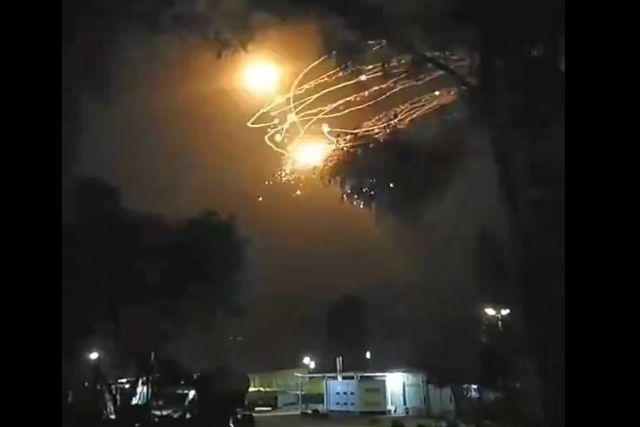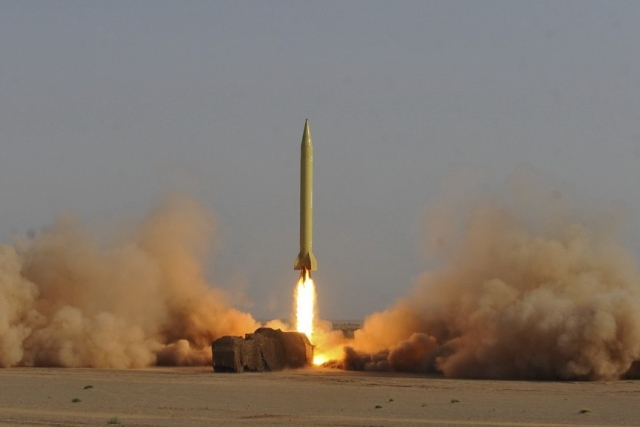Have Iran-Israel Missile Attacks Enabled Mutual Deterrence?
Will Iran’s new missile capabilities stop Israeli attacks on Iranian interests in Syria, Lebanon, and within Iran itself?

Israeli air defense intercepting Iranian missiles @X
Iran's April 13-14 missile strike against Israel marks a paradigm shift in Tehran's approach to Israel; from previously relying on its proxies to direct strike on Israeli targets.
While the barrage of missiles may have been largely intercepted by the combined air defenses of Israel and its Western allies, some did get through and struck at the runway of the Nevatim airbase in Southern Israel. Some reports said in addition, the Meron airbase in Northern Israel was also hit by missiles.
This indicts that Iran’s vast array of long-range cruise and ballistic missiles can penetrate even the best of air defenses due to sheer volume of missiles launched.
Israel crossed a ‘red line’ with embassy bombing: Iran
The April 1 Israeli bombing of the Iranian Embassy in the Syrian capital, Damascus that killed six military advisors including two generals is considered a “red line” by Iran that prompted the April 14 massive missile attack.
In response, a missile, so far unacknowledged by Israel, a hit in the vicinity of the Iranian city of Isfahan on March 19 without causing much damage. The “tepid” response as some Israeli politicians called the attack, is indicative of the pressure on Israel to avoid a full-scale war against Iran for fear of engulfing the entire Missile East in a conflict.
David N. Yaghoubian, a professor of history at California State University, San Bernardino, told Iran’s state-owned IRNA that Israeli attacks (against the Iranian embassy in Syria) “resulted in a large-scale retaliatory attack by Iran to “simultaneously punish Israel, and to announce the end of its ‘strategic patience’ with the Zionist and American aggressors and their delusional conceptions of proportionality.”
Power of deterrence with Iran?
The subdued Israeli response is just what Iran may have wanted from its massive missile barrage. Iranian Army’s chief of staff, Mohammed Bhageri has threatened that Iran is capable of missile attacks “10 times more than what occurred on April 14.”
Iranian President Ebrahim Raisi has emphasized that if Iran had opted for a more forceful operation, Israel would have endured even more significant repercussions.
Deputy Foreign Minister Ali Bagheri Kani has emphasized that there will no longer be a delay of days between an Israeli move and Iran's “powerful response.”
Does this mean that the power of deterrence has shifted to Iran with its low-cost military assets of drones, ballistic and cruise missiles?

Iranian long-range missiles and their reach
|
Missile Name |
Class |
Range |
Status |
|
Emad (Shahab-3 Variant) |
MRBM |
1,700 km |
In Development |
|
Ghadr-1 (Shahab-3 Variant) |
MRBM |
1,950 km |
In Development |
|
Khorramshahr |
MRBM |
2,000 km |
In Development |
|
Qiam-1 |
SRBM |
700 - 800 km |
Operational |
|
Sejjil |
MRBM |
2,000 km |
Operational |
|
Paveh 351 |
Not known |
1650 |
Operational |
|
Shahab-3 |
MRBM |
1,300 km |
Operational |
|
Soumar |
Cruise Missile |
2,000 - 3,000 km |
Operational (presumed) |
|
Ya-Ali |
Land-Attack Cruise Missile |
700 km |
Operational |
|
Zolfaghar |
SRBM |
700 km |
Operational |
Source: Media reports
Drones + Missiles swarm used in attack on Israel
Iran apparently “informed” America through the Swiss diplomatic mission in Tehran 48 hours before attacking Israel leading to fighter jets and air defenses in full preparedness. Interception of a large number of missiles and drones by Israeli, American, British, French, and Jordanian fighter jets was made possible due to having sufficient advance information.
In this context, the possible impact of a surprise Iranian attack with an even greater number of missiles than on April 14 holds a real possibility of significant damage inside Israel.
Iran revealed advances made in missile technology in the attacks on Israel. Among the Iranian missiles, was a new maneuverable ballistic missile, the Emad, designed to evade missile defense systems by maneuvering after entering the atmosphere. Iranian media has claimed that many of the Emads managed to break through the web of Israeli and Western air defenses.
"This was the first time that precision Iranian missiles were used against Israel in an operation, in the largest ballistic and cruise missile attack ever recorded," Tal Inbar, an expert on the Iranian missile program, was quoted as saying by The Jerusalem Post. "Not even the Russian missile barrage against Ukraine reached these dimensions. By intercepting the missiles through cooperation with foreign countries, we saw the implementation of capabilities and joint operational language developed in the Iron Shield Operation conducted by Israel and the US, with a most impressive success."
Israel's malign activity against Iran has been a regular feature of its military and intelligence agencies over the years.
From the targeted killings of several Iranian nuclear scientists in 2010-2012, to the daylight shooting by a remote-controlled machine gun of top nuclear physicist Mohsen Fakhrizadeh in November 27, 2020, to the explosion in Iran’s Natanz nuclear facility in April 11, 2021, the Israeli response to Iran’s nuclear program have been marked by covert operations, assassinations, and sabotage.
Israeli intelligence agencies have been blamed for these acts though the country's government has never owned up the killings and destruction.

In addition, Israeli warplanes have struck targets in Syria and Lebanon at infrequent intervals over the last few years where in most of the attacks Iranian military officials or equipment has been killed. The Damascus and Aleppo airports have been partly damaged in these attacks.
“Iranian officials have subsequently made it clear that in the interests of regional peace and stability and in the service of international law, continued recklessness and rogue behavior by Israel or other enemies will be met with legitimate self-defense in the form of increasingly strong military responses launched directly from Iranian territory. Thus, deterrence has been clearly and effectively established via this legitimate and well-deserved slap in the face of Zionism and American imperialism,” Yaghoubian added.
Table showing purported Israeli attacks on Iranian military advisors, scientists and assets over the years:
|
Date |
Target |
Details |
||
|
January 2010 |
Masoud Ali-Mohammadi |
Physics professor at Tehran University. Killed by a remote-controlled bomb planted on his motorcycle. |
||
|
November 2010 |
Majid Shahriari |
Professor at the nuclear engineering faculty at Shahid Beheshti University in Tehran. Killed in a car explosion on his way to work. |
||
|
January 2012 |
Mostafa Ahmadi Roshan |
Chemical engineering graduate. Killed by a bomb placed on his car by a motorcyclist in Tehran. |
||
|
November 27, 2020 |
Mohsen Fakhrizadeh |
Top nuclear physicist. Assassinated in a daylight shooting by a remote-controlled machine gun. |
||
|
April 11, 2021 |
Natanz Nuclear Facility |
Explosion at Iran’s primary uranium enrichment facility in Natanz. |
||
|
April 2024 |
Iranian Military Advisors in Damascus |
Israeli missile strike on a part of its embassy building in Damascus resulted in the deaths of at least five Iranian military advisors. |
||
The big question is, will Iran’s newly established missile power halt the frequent Israeli attacks against Iranian interests in Syria and Lebanon, not to mention covert attacks inside Iran? Furthermore, will Iran cease supporting pro-Shia groups in Syria, Iraq, and Lebanon to maintain this deterrence?









